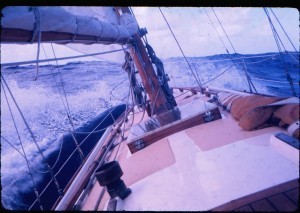Completing the “milk run”

Our boat tied to the dock inside the lagoon of the atoll Ahe in the Tuamotus, French Polynesia
by Christine Kling
Today it’s difficult to remember what life was like without GPS. Nothing has changed the life of the cruising sailor as much. Having to find one’s location with a sextant and celestial navigation was so dependent on weather and the navigator’s ability. If the seas were extremely rough, it became much more difficult to get a fix and made star fixes on a small boat almost impossible. When it was overcast, you could only continue your dead reckoning from your last fix. When we sailed from Hawaii to California, our passage took 23 days and we had solid overcast for the last 9 days of the trip – meaning no fix was possible. And night time entrances to a strange port were never even considered as they are today with our glow-in-the-dark chart plotters.
The other thing that celestial navigation impacted was cruisers’ decisions of where to go. There was a route across the South Pacific that was considered the “Milk Run” and only the most courageous sailors veered off that route. For example, the Tuamotu Archipelago covers a huge area between the Marquesas and the Society Islands. There are over 70 islands in the Tuamotus but most cruising sailors in the 1970′s only visited the islands around the edges as they are atolls that are only visible from about 5 miles off. We stopped at Ahe and at Rangiroa, and I’ll never forget sailing along the coast of Ahe and counting the number of sailboat wrecks visible high up on the island’s beaches. It was a frightening reminder of how dangerous it could be to get off course and arrive at the island in the dark.
Today, I’m sure cruisers visit many other islands in the Tuamotus and throughout the South Pacific because GPS has made it possible. It has opened up vast new areas for the cautious cruising sailor.
The end of the “Milk Run” across the islands of the South Pacific ended for us with a 10-day passage down to the Bay of Islands in New Zealand. On our low tech cruising boat we only had an all-band receiver for a radio and our entertainment in the evenings on that passage was to tune in to the cruiser’s net on the ham radio bands and listen to them discussing how to figure out where they were. On that trip from Tonga to New Zealand, you see, we crossed the International Dateline or 180 degrees of longitude. For the folks who had learned a certain rote formula for celestial navigation and didn’t understand the theory, they were suddenly faced with a mathematical dilemma. How did they differentiate the numbers when they changed from west longitude to east longitude and their numbers that had been increasing started to decrease? It made for several evenings of amusing radio chatter.
 On that ten day passage as we sailed farther and farther south, we encountered a couple of nasty gales that let us know we were approaching the Southern Ocean. Long pants and sweaters got pulled out of lockers and night watches seemed to grow frigid. Finally, we sailed into the protected waters of the Bay of Islands with barely enough daylight left to make our intended anchorage off the town of Russell.
On that ten day passage as we sailed farther and farther south, we encountered a couple of nasty gales that let us know we were approaching the Southern Ocean. Long pants and sweaters got pulled out of lockers and night watches seemed to grow frigid. Finally, we sailed into the protected waters of the Bay of Islands with barely enough daylight left to make our intended anchorage off the town of Russell.
Several years previously when Jim had lived in California he had been best friends with another boat builder – a Brit by the name of Denis Brown. Denis had designed and built his boat Ravensong and left for the South Pacific a few years before Jim. Somewhere along our route in the months we passed through those islands, Jim had written Denis and his wife Eva telling them that we were planning to spend the southern summer’s hurricane season in New Zealand. Denis had told his friends with hilltop houses to keep a look-out for our Islander 44 with a varnished spruce mast to come sailing into the bay. We, of course, had no radio to call ahead and tell Denis of our arrival.
So, imagine our surprise when after ten days of fighting a cold rough sea, we barely got our yellow Q flag up and our anchor into the water when a lovely lapstrake skiff pulled alongside and there was Denis at the oars welcoming us to New Zealand with a loaf of fresh bread and a glass bottle of non-homogenized milk with two inches of cream on top.
At the end of our milk run, we’d found our home for the next six months.
Fair winds!
Christine
Share on Facebook



